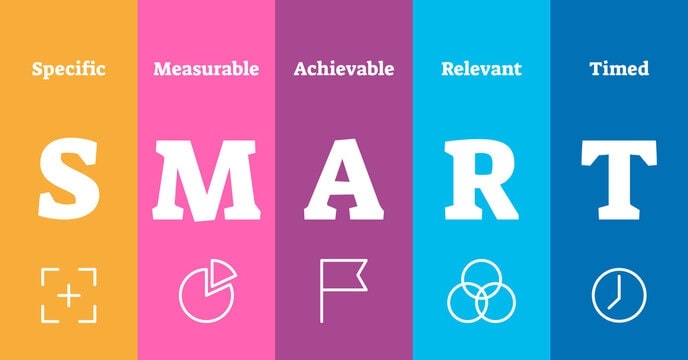How to build a Social Media Marketing Strategy for your marketing plan in 2024
Social media is a network of more than 4.3 billion users who only enjoy sharing, looking for, and developing content. Social networking networks are fast becoming an inseparable part of strategies for business growth. When it comes to establishing substantive relations with customers you can no longer ignore the effect of “social.” 71% of customers with a positive social media experience with a brand would suggest this to others, according to Ambassador. However, 96% of the people who talk about brands online do not follow the profiles of these brands.
A strategy is the main component to successfully do social media marketing. You could post on social media sites to post them without a plan. It would be difficult to achieve results in social media, without knowing your targets, who your target group is, and what they want.
Either by social networks or as a social media marketer you want to improve your brand, it is crucial to develop a social media marketing strategy. Below is a detailed guide for those seeking to accomplish effective marketing strategies that simplify social media marketing.
What is social media marketing?

Social media marketing provides information creation on several social media sites such as Facebook, Instagram, and Twitter to promote the company and products. You should customize your relevant content to the particular channel it is shared to help you improve conversions and raise brand awareness.
Social media marketing means reaching your target audiences and clients and interacting with each other and your brand socially. Although social media marketing as a whole is extremely valuable and useful to your business growth, the social networks your public spends time on are different depending on your tailored strategy.
The increasing importance of social media marketing in 2021

Consumers today tend to search social media to find out more about a company or product because others are talking about it. You’ll miss a chance to make an impact when you have no social media presence.
Statistics gathered by Orbelo have revealed some important indications about the growth of social media usage. Firstly, brands are likely to be recommended to their friends and families by 71% of customers with a positive experience with social media. Active social media users account for 90,4% of the Millennia, 77,5% of Generation X, and 48,2% of the Baby Boomers. Also, about 2,7 billion active users are on Facebook alone.
A friendly reminder is that your clients and prospects use social media platforms every single day. Social media is a perfect place for marketers to learn about the desires and preferences of their audiences. Experts see this as a means to ensure sustained market growth for smart businesses. If you are planning to introduce a new product or business, social media is the best way to boost your initiatives. As we step into the future of e-commerce, social media marketing is not just an option. Your company cannot afford to skip social media in an increasingly competitive world.
Benefits of social media marketing
There are many reasons for using social media marketing for your company. You may develop a social media marketing plan to gain a wide range of benefits by engaging with potential buyers in two-way conversations to broaden the extent of what you sell.
Increased brand awareness

In reality, it has been shown that social media are increasing brand awareness through interaction. Social participation involves such things as tweets, likes, shares, and re-posts. Social networking also helps to raise awareness of the brand by direct traffic to your website. You can do this by inserting links to your profile, biography, and updates to your website.
Social media marketing opens doors to instruments and strategies that make it possible for the company to reach a new audience. You can use content to link your target audience with and warm up Facebook and other social networks. While it’s difficult to get the attention of people, with engaging material, you can easily break through the noise. For instance, making an interesting Facebook video advertisement will help people learn more.
Stronger relationships with customers

Successful brands establish enduring partnerships and communicate with their social media audiences. If they post something on the website several times, they reply to anyone who leaves a message or query to help them.
You may simply ask your social media followers questions about your goods or services rather than sell them, or post something which can make life far simpler for your audience. In this way, you create trust and credibility by showing how involved you are with their needs and opinions. It is always a must to first serve people before they ask them to engage with you.
Lead Generation and Conversion Boost

Promoting and sharing social media products is an easy way to enhance lead generation, increase conversions and boost sales since you are advertising to people who want to join you via your account.
Facebook, Instagram, Twitter, Linkedin, and many more platforms enable business leads to be generated. To boost conversions, you can use a combination of paid and organic techniques. Video ads, paid advertising promotions, gifts and email opt-ins are some of the leading tactics for your business funnel. For instance, a Facebook gift campaign will help you increase your list of qualified email addresses.
Social media marketing is a measurable, faster, simpler way to build a database of perspectives since everything goes online. Your company sees plenty of conversion opportunities with improved exposure. Compelling content will lead your followers on social media to the website of your company and make them trustworthy.
Cost-effectiveness
Social media marketing is possibly the most inexpensive and varied way to promote a business. The development of a profile on most social networking sites does not cost anything. If you want to launch a paid campaign to promote your content, the cost compared to other advertising channels is relatively low. If well done, the chances are higher that your investments would generate greater returns.
You can always do anything to better the performance of digital ads. One of the advantages of social media marketing is that it helps you to track your success using better understandable-time data and to refine your strategy.
Competitor analysis
Social networking is a perfect way to keep an eye on your rivals, be it in terms of your social media strategies, your brands, your campaigns, or your level of contact with your followers.
Social networking allows you to look at what works and does not work with your competitors and also lets you determine if your company strategy can or should not change. Finally, you should check your competitors’ social media to ensure that your content is exclusive to your brand.
You can start testing things that work for your competitors. For example, you can try it too if paid Facebook ads produce good results for your competitors. You can, however, not copy your competition to harm your brand, but ensure that it stands out. You can see all they’re doing by visiting the Facebook ad library if you want to see what kinds of Facebook ads your competitors display.
How to build a successful social media marketing strategy
Your approach is like a plan, everything from objectives to actions. When the strategy becomes clearer, the more results it gets. Plan things in a way that can be achieved and measured. When a straightforward plan is in place, your online business must be run smoothly across an all-in-one system.
1. Set clear objectives and goals

The strategy of social media begins with your objectives. Maybe you want to build a group or a devoted one. Maybe this year you want more revenue from your social accounts. In any case, your goals will determine the approach of your content and how long and energies you need to spend on your campaigns. Set your objectives following the S.M.A.R.T framework for better measurements.
S - Smart: The more precise your objectives are, the simpler a straightforward approach and priorities would be to set. Be clear on how you want to do this if you want to increase your brand recognition. Let us say that your objective is to improve your Instagram by 400 new followers every month.
M - Measurable: You can easily assess your performance when you set clear goals. You should change your plan to boost performance if you don’t get 400 new followers a month.
A - Attainable: Companies often become too greedy and finally set unrealistic, unattainable objectives. Make sure your goal with your capital is achievable. Now, 400 new followers on Instagram can be reached.
R - Relevant: How will your targets for social media marketing affect your results? Will you help you reach your company objectives by increasing your Instagram? The relevant goals are closely associated with the mission of the company.
T - Time-bound: Ensure that deadlines are defined. Once more, be practical.
The benefit that the rise in your social media would bring to the table may be difficult to detect. It is therefore advisable to concentrate on measures such as conversion rates, clicking through, and participation. You can set different targets and follow up your results appropriately for each social media network. Below are a few example goals for companies of all shapes and sizes.
Increase engagement
Explore ways to take your existing followers’ focus. This means testing messages and material. Does your brand promote content and hashtags created by users, for example? Even something as basic as questioning will boost the participation rate. But only if you give them something to do, your customers will be their strongest supporters.
Boost traffic to your site
You can do so by using social media to generate leads or traffic to your website. Regardless of whether promotional posts or viral ads allow you to better identify your ROI on social media, monitoring conversion and URL clicks.
Grow your audience
To bring new people into the fold means to find ways to show the brand to people who have not heard of you before. To grow your audience means to experience the discussions that matter most to your company and industry. Without reading or listening to unique keywords, phrases, or hashtags, navigating through social media is almost impossible. With a pulse on these talks, the core audience will hit you even quicker.
2. Do research on your target audience

Research your audience to have a better understanding of how you should identify who your buyer individuals and the audience are so that you can properly address their needs and desires. Think of the people that you want to meet and why, and how you identify them as a group.
When you look at the people and audiences of your buyer, you will be able to decide what content will draw followers and clients you want to obtain and how it will keep your followers engaged.
Create customer personas
The development of audiences is to create an ideal customer’s persona representation. This means that people draw a clear picture of their ideal customers. If your audience is baby boomers, high school students, or senior citizens, build an individual that works for a more efficient, concentrated approach.
Age, area, language, average revenue, interest, purchasing power, and pain points are the main factors to be considered. Let’s presume your audience is a collective in their late 20s of single moms who live and work in big cities. Take these abstract demographic information and characteristics into a persona.
Use collected data
When studying your target group, don’t just assume anything. To make informed decisions, instead, use data. Let’s say, teenagers are your target audience. Using the data now to choose the best social media platforms.
Social media analysis offers you many useful details about who your followers are, what they do, where they live, and how they communicate with social media companies. Use this perspective to classify the audience better.
3. Choose a platform to share your content

As a marketer for social media, it is important that you decide which channels you can share your content with. When it comes to social media your business can use, there’s not necessarily a positive or negative response, but rather it’s about the needs of your target audience and the time they invest.
Each platform has its own pace as well as a certain number of users who engage with content with their behaviors. A person with YouTube could not use Linkedin for the same purpose to watch their favorite show. As hundreds of social media sites exist, it’s not just possible to use all platforms in your plan. Moreover, on any platform, you cannot publish the same content. So, when choosing the ideal platform for your marketing strategy, it is necessary to do some preliminary research. Here are a few tricks you can learn from.
Carefully consider your target demographics
What are your customers aware of? Are they younger, older, men or women? We have already discussed how a brand can increase its audience’s awareness. You will find channels that match your approach when you research demographics.
If your biggest consumer segment are women who are 50 years old or older, for example, creating a Snapchat presence will not be a good idea for your business. Similarly, if your target audience is only males, building your Pinterest presence will be a waste of your efforts. Often the best result is Facebook, YouTube, or Google, or Linkedin, for some.
When you add social networks to your approach, it is also important to remember your business goals. To maximize customer service, for example, you should prioritize Twitter. Instagram would be the perfect choice if you would present your offers in a visually convincing fashion.
The trick here is to match your company priorities with the platform advantages. Find a perfect medium between what your clients are like and what you should use or advertising.
4. Do competitors research

By checking your competitors’ social presence, you will gain valuable insight. In this regard, the methods of competitive analysis can be of great benefit. You will learn a lot from your rivals (for instance, what tactics are not working for their needs).
A business analysis defines not just your rivals but gives you a clear understanding of what you can expect from your social presence. List only five brands that compete in social media most closely with you. And then you will evaluate the strengths, limitations, opportunities, and risks of your company and competition. Analyzing how your rivals use social media to improve your company can help you identify opportunities. You do not have to follow exactly what your competitors are doing - just take it as a reference to reflect your business’ strategies for further adjustments.
5. Establish realistic budget allocations
Social media marketing is as viable a means of commercialization for most businesses as any other type of marketing, and a budget should be made available accordingly. If you just tag it in the current list of tasks your existing office staff carries out, you cannot anticipate social media success!
On the other hand, if that is where your objectives lie most, you can invest no more in your social media business than you can realistically gain in improved revenue, market recognition, or brand awareness. Like any marketing method, you can measure the ROI from your social media spending, taking into account the targets that you set earlier in your plan.
You should think about how much you want to invest in digital marketing across all platforms when setting a social media budget. Then ask yourself how much you are willing to spend on social media.
6. Create attractive content
You should have a clear idea at this stage about what channels you need to target. It is time to discuss content and how to make it more interesting and attractive. To create content that is shareable and enjoyable, you consider your audience’s psychology. Then you can see just what makes them happy and excited. Here are a few ways to generate outstanding ideas for your content.
Learn from competitors
Consider the content your rivals share and how you can market your products. To help you become innovative. Use the functionality of the platform that you are using as well. You may, for example, create live videos on Facebook to share or give away the latest information about a product release.
Use current followers
To help you produce content, use your existing customers and supporters. You may do this by re-posting the contents or prompting them to share their experiences and photos of their products with a hashtag.
Use keyword search
Although research and analysis of keywords are important for search promotion performance, searching keywords will significantly increase your social media visibility. If it is on Instagram, Facebook, or YouTube, you can use your audience’s keywords to find their preferred social media contents, which allows you to reveal their social needs and expectations. The research and identification of the right keywords in social media can better understand how your message can be effectively structured.
7. Schedule your posts
A social media management solution is one of the simplest ways of ensuring that the content can be shared as planned. You can write subtitles, prepare photos and films, and plan posts by using these resources. They also share your content on time automatically and track all posts and interactions. Solutions in social media management save you time and let you concentrate on other tasks.
Set up the schedule on your calendar
The dates and times you will publish the content styles on each canal are listed in your social media content calendar. This is the best place to schedule your whole social media work, from photos and sharing links to blog posts and videos.
It includes your daily posting and social media campaign material. Your calendar also ensures that your posts are well spaced and optimally written.
Decide the right content mix
Check and confirm that your calendar represents each social profile’s mission statement so that all that you share supports your business objectives. You’ll retain the correct mix if you place these various styles of posts into your content calendar.
If you start from scratch and you are not sure what kind of content you should publish, try the rule of 80-20:
- 80% of your posts will inform, educate or entertain the audience
- 20% of your posts will aim to boost your brand recognition
Using a scheduler to plan messages instead of continuously changing them throughout the day once your calendar is set.
8. Measure and analyze your performance

One of the most critical aspects of social media marketing is to ensure that you achieve your goals. You will need to track all your posts on each channel to decide this. You can do this through social media analytics analysis and management.
Analyze social media metrics
Social media metrics are data relating to your popularity and your effect on different channels for your audiences and customers. These measurements will include data about your level of commitment, your likes, your follow-ups, your behavior, and any interactions on each platform.
By using the same metrics, you will control all these parameters, raise your social follow-up and increase the overall commitment to your profile. You may also communicate more often with your followers by speaking with them, tagging them in content, answering their questions, enjoying their tweets, inviting them to use your hashtags, and sharing your content.
Conduct constant testing and re-evaluation
When this information begins to appear, use it periodically to reevaluate your strategy. This knowledge is also available to test various positions, campaigns and strategies. Constant testing helps you to see what works and does not work to improve your strategy.
Surveys can also be an excellent way to see how well the plan works. Ask your followers, email lists, and web users if you fulfill and want to meet their requirements and standards. Then ensure that what they tell you is delivered.
8 best social media strategies to win over 2021 marketing trends
2020 has been a year of transformation for social media, seeing more people than ever before who are linked to their smartphones. While we believe several marketing strategies in social media are still in place since last year, it is time to look ahead. Many brands decided to upgrade their social media marketing strategies to use a range of emerging trends in 2021. Below are some of the most up-to-date strategies your business can consider to catch up with the race.
1. Use TikTok as one of the key strategies

The bite-sized videos of TikTok were a major success in 2021 and were a pioneer of a new approach to social commitment as a social media marketing strategy.
Instagram has also adopted a new approach to enhance interaction by developing reels, which will enable influencers to create 15-second videos for their followers. Some companies use their TikTok content to gain a wider range. Repurposing your content will help to reduce the exhaustion of creating content.
TikTok is loved by gen Z and, to a lesser degree, millennials. You should make short-form videos for the platform because they are your target market. Trends are important to TikTok’s viewers, so take note of the latest trends as soon as you notice a short video that follows the trend. Much like YouTube, you need to choose a niche that will interest your target audience for your TikTok videos. With short TikTok videos, you have to post frequently to hold your viewers’ attention.
2. Create a community for your audience

A clear community for them is one of the best ways to engage with the audience. Try to be interactive in your posts and include the audience. You can have questions and quizzes to gather the opinions of your followers. Be sure your articles are interesting - whatever you do. You want your followers to return frequently to your posts, so they have to find their worth.
One thing you need to think about is who your social media marketing is running for. Ideally, employees should fit the target audience’s social demographics. So if you target Generation Z, you can use your youngest staff to run Instagram and TikTok accounts of your business.
Perhaps you can look for the current homeowners to run Facebook accounts if you are targeting home renovators.
Facebook groups are suitable for B2C enterprises; and if your emphasis is more on B2B, consider LinkedIn. On one of these websites, you could build a community to persuade the audience.
3. Try micro-influencers marketing

For many reasons, partnerships with respected and well-connected influencers are a wise idea. It will increase your marketing scope dramatically in addition to an increase in reputation. The art of social media marketing has already been mastered by influencers – their power.
You should think of partnering with influencers and directing them to your social places. While smaller followings (from around 1K to below 100K), micro influencers’ audiences are more involved and dialed in. As a result of your relationships, your booked people are certainly more likely to be your ideal clients and to work with you. Moreover, it is always easier for micro-influencers to get in touch and to convince than superstars of social media.
Of course, when they arrive at your pages you will have to build content that will impress them. If you pick influencers whose followers suit the target group and give quality content to people who influence you, you have the possibility that they will also become your social followers.
4. Go Live streaming

Enter a social media site and there will be or will be a live stream. Live social media was already common in 2021, with famous, influential people and daily people enjoying live media excitement.
Live viewings on Facebook increased by 50% during lockdown times, while Instagram viewing increased by 70%. TikTok is using a shot up in 2020 and we have a fair chance that we shall still see this upward path in 2021.
Human-driven content such as live streams will build trust and tap into the current link that customers want in 2020. Enterprises use videos for workshops, webinars, debates on business issues, and launches of products to name a few. Therefore, it’s perfect to start using live videos if you want your social media marketing strategy to perform well in 2021.
5. Enhance customer experience with user-generated content (UGC)

Customer experience is more significant than ever. Customers are seeking fun and unforgettable interactions with brands. Consumers are 2.4 times more likely to perceive user-generated content as authentic than content produced by brands. This gives brands a significant boost in reputation, as most people say that fewer than half of brands produce authentic content.
All the previous advantages of content created by users actually lead to this: the effect on buying decisions. Almost 80% of customers have stated that UGC has a major effect on their purchase decisions.
When sharing user-generated content to encourage buying, don’t forget Instagram Stories. When you combine the emotional power of stories with the permanent power of highlights, a permanent album can be created to allow potential consumers to watch for as long as they feel comfortable going to your site for purchase.
6. Use your social media platforms to sell online

Many companies have switched their selling platforms to online this year. Shifting to online sales for businesses commonly depending on foot traffic and brick-and-mortar location was important as a social media marketing strategy.
Social media networks provide a wide variety of useful solutions for marketing, including online shopping. This marketing strategy has already been adopted by Facebook and Instagram by purchasing shopping capabilities for their applications. Social media users can now buy and sell online items with shoppable messages.
You have to leverage social media platforms like Instagram shops and Facebook shops if you’re in the business of eCommerce. People may find Facebook shops or find them with stories or ads on a business’s Facebook Page or Instagram account.
The development of social media stores in 2021 may be an excellent way to boost your profits when your company sells a product or a service. Not only will the social media involvement increase, but you’ll also be able to reach a broader public and future sales growth.
7. Leverage Virtual reality and Augmented reality

Virtual reality is attracting customers more and more. As a result, both virtual reality (VR) and augmented reality (AR), both on Instagram, TikTok, and other platforms, are constantly explored as marketing instruments. Several brands increase viewer engagement either through full immersive experiences that shut off the physical (VR) environment or through interactive elements applied to a live view.
AR app development does not need extra hardware other than a smartphone, which makes it much easier to reach than VR. They are also known for interactions such as interactive picture filters on many social networks for years.
Inherently immersive and highly successful for interaction are increased reality interactions. By developing AR filters to advertise new products or promote fan engagement marks are easily integrated into the latest trend in social media. This keeps your audience active and entertaining and can also encourage you to draw new customers.
This enables your prospective consumers to consider your goods, services, and customer experience in the way that they use mobile cameras. As a consequence, you can influence your decision directly, which would benefit your business.
8. Consider purpose-driven campaigns

Although social networks have always promoted the involvement of causes, the global pandemic has highlighted these causes even more. More than ever, people want to support, and brands expect to chip in.
74% of those surveyed on Twitter want brands to show compassion. 86% of the interviewees want brands to help disadvantaged community members. And 82 percent hope to receive more assistance from healthcare professionals on the front line.
Since brands have experienced many crises in 2020, credibility is also emphasized and their marketing actions are supported. It is important to know when to engage and how to avoid a sensitive problem that cannot be considered applicable to your brand. Audiences want brands to demonstrate leadership and positive social change instead of exploiting them for marketing opportunities.
Final Words
Given that today there are millions of users in social media, it’s easy to see why so many companies and advertisers use the media for advertising and engaging with their brands.
While you might find the way your company works in social media overwhelming, knowing the trends in social media marketing and using some of the many available tools on the matter will prevent you from becoming overwhelmed. Begin working today to increase your followers’ numbers, strengthen commitment and boost conversion in your business’s social media marketing campaign.
New Posts

How To Set Up Google Analytics 4 For Your BigCommerce Store






